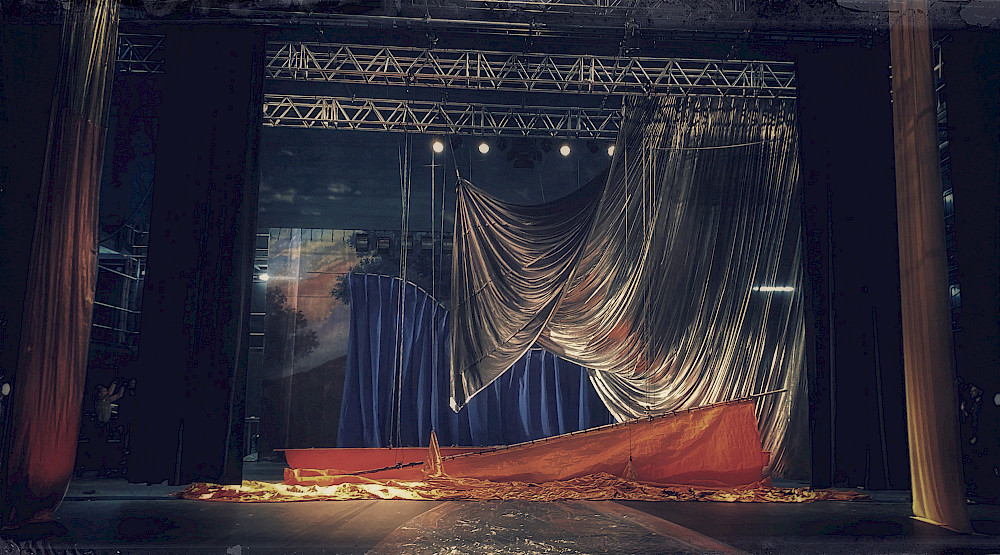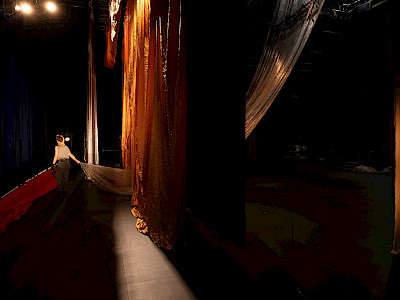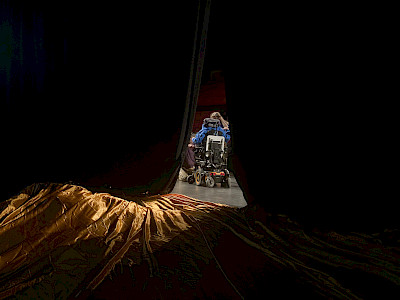27 — 31.05.2025
Nicolas Mouzet Tagawa, / Proche Quartier Brussels
La vieille dame et le serpent
theatre — premiere
| French → NL, EN | ⧖ 1h25 | €21 / €17 | Contains references to anorexia
Brussels-based director and scenographer Nicolas Mouzet Tagawa combines politics with a reflection on the theatrical form. Active in the voluntary sector, particularly in exploring alternatives to institutional psychiatry, he is fascinated by the power of theatre as a machine for creating other realities. In La vieille dame et le serpent, Mouzet Tagawa uses theatrical machinery to question the concept of 'institution'.
How do we inhabit the institution, and how does the institution inhabit us? What exactly happens when we enter it and when we leave it? Three people share the stage: Claire Rappin, a clown enthusiast whose personal story runs through a healthcare structure, Guillaume Papachristou, a person with cerebral palsy whose routine has long been regulated by an institutional framework, and Bastien Montes, an actor and personal assistant to Papachristou.
La vieille dame et le serpent is a poem for the stage in which the set is also a central character. In a dance of theatrical canvases manipulated by visible stagehands, the set becomes an instrument symbolising both the social and healthcare fabric. The result is a theatrical piece that is undeniably visual, formal and committed, questioning social and theatrical conventions.
Interview with Nicolas Mouzet Tagawa
During the 2000s, you were a social worker in Marseille, working with children diagnosed with autism-spectrum disorders. You say that it is through this experience, seeking alternative means of communication, that you were led to create your first performance works.
Later on, I realised that the creations I made while in contact with children were the same as those I created for the theatre. One day, while I was failing to communicate with a child diagnosed with autism-spectrum disorder—no words available to allow us to understand each other, nothing happening—tired and desperate, I went up into the attic of the school. There I discovered an old window frame. I decided to inject something tangible into my relationship with the child. So I placed the window frame between him and me, without really believing it would work. Gradually, we agreed with each other about the verbs “enter”, “leave” and “turn around”. From then on, the child was able to go into the playground, to the toilet. Empirically, this method produced meaning.
In the way you make the theatre space itself the subject of your creations, there is the wish to lead a re-exploration of expectation, and of the disconnection of vision. No doubt this is in order to find “the fictive actions”, and “the narrative texture”.
From my very first work at Insas, I was interested in actors and in poets. In poetry, the question of experience is very important. That is what I hold on to, in my desire to make theatre: to pass on what affects me. Poetry, in what it offers of the passage of danger, disconnects my relationship with the page, with time and with space.
Creating my piece, Le Site in 2022, aroused my desire to discover Brussels in another way, bringing me closer to a particular community, that of L’Autre “lieu”-R.A.P.A, a place which offers an alternative to institutional psychiatry. Like poets, the stories of experiences enrich my reflections. In a way, the living are at the table with us. In the theatre, I am obsessed with learning constantly, not learning information, but instead tensions, new relationships. I seek forms in space there, and I learn from them. That leads me to question myself about the multiplicity of viewpoints and the invisibility phenomenon.
In La vieille dame et le Serpent, you appropriate the theatrical machinery, especially the curtain, at the start of a process of questioning the concept of “institution”. The scrambling of boundaries, and the inseparable bond
between body, space and aesthetic, form the richness of your work. That is also where its critical weight lies.
One day, my friend and mentor Jean-Pierre Raffaelli, who led the Dramatic Arts department at the Conservatoire Pierre Barbizet in Marseille, told me his memory of a detail as he emerged from his coma: every day, the nurse, after changing his catheter, murmured “there you are, it’s done”, gently stroking his arm with her finger. Overwhelmed, he told me, showing me his index finger: “we never finish learning about people”. He felt that the nurse saved his life, by making this gesture every day, outside medical protocol.
While speaking with a friend, I became aware that the nurse’s gesture is in fact a very strong gesture of friendship within the routine of the medical institution. This led me to question myself at length: what imaginary worlds do institutions hold? Why do small gestures of friendship produce such emotions, and such astonishment?
Shortly afterwards, I dreamed that I was in a theatre, with a woman friend. On the stage, the black curtains demarcate the space. I spoke to my friend about what I saw, and what questions I was asking myself. My friend said to me: “everything you’re telling me about institutions and the fabric of community makes me think about the theatre curtain. And from there, the old theatrical, institutional imaginary world. Don’t you think that the key is quite simply movement, emotion, transformation?! Anyway, look! The curtains are dancing”. I turned around. The curtains were actually coloured orange, and blue, and were indeed dancing. And my friend went away.
In La vieille dame et le serpent, I explore the most traditional theatrical machinery, the fabrics, the curtains and their folds, but also the bodies, with one question in my mind: can the theatre receive these little gestures of friendship which resurrect life?
In La vieille dame et le Serpent there is the possibility that the changed perception of space, of the visible and of the appreciable, arises in the part of the waking dream through moving images, the multiplying movements of monochrome fabrics. As if they are carrying the promise of emancipation; what happens when art is not a separate reality, when art is transformed into a form of life.
So I can no longer “turn around”. I want to “set in motion”. When I discuss the creation of La vieille dame et le Serpent, it is not unusual to find that I’m expected to criticise the institution. But that’s not where I am. What leads me to wish to open up the perspective, is the sense of friendship found when exploring my reflections on the institution. A responsibility, in short. The friendship among Bastien Montes, Guillaume Papachristou and Claire Rappin is one of the main issues in the piece. The way in which they met, the way their paths in life cross, from the care institution to the theatre stage, were absolutely unpredictable. That’s precisely what gets their bodies moving within these institutional accounts. It’s opening up! I see holes, tunnels appearing within the moving fabrics. The quivering in the space has enough nerve to understand that the stories of Bastien Montes, Guillaume Papachristou and Claire Rappin are similar to the mythologies they inhabit.
Is this specific mode of habitation of the appreciable—by the performative action, even this sense of existence, what Bastien Montes, Guillaume Papachristou and Claire Rappin evoke in their conversation?
They evoke it very simply from their sometimes very complex experiences. Their stories do not make “event”. That is precisely where our main challenge lies: not to resolve the writing. Their stories are not finished, they continue in their questioning.
In reality, their way of telling, stripped of any theatricality, is as important as what they are telling. The idea is not to finish there with the theatre, but on the contrary, to place their relationships at the centre, just like those that exist with and between the stagehands Britt Roger Sas and David Alonso, who are visible. This requires close attention. The least false step could tip us over, in the theatre production. That’s what I don’t want.
Could it be said that La vieille dame et le serpent is the search for a revolution in awareness, like a form of resistance which allows us, through the creation, to inhabit a society where freedom is gained in the ways we feel, perceive and connect together?
I don’t know if it’s the theatre’s responsibility to be revolutionary. Perhaps that’s too ambitious?! (Laughter)
If there’s a quest, it’s that of preserving human dignity. And above all, remembering that movement is what people do. We have to see them, including those who are supposed to be in the shadows. As are Britt Roger Sas and David Alonso in the piece. We have to offer ethical emotions; those which demonstrate that behind the beauty, the magic, the transformation and the thought, there are always people helping each other.
- Interview by Sylvia Botella in April 2025.
- Translated by Joanna Waller.
- Sylvia Botella is a dramaturg at the Théâtre National Wallonie-Bruxelles. She is also a critic, and teaches in the Master en Arts du Spectacle programme at the Université libre de Bruxelles and in the Master Interprétation dramatique at the Institut des Arts de Diffusion – IAD.
Presentation: Kunstenfestivaldesarts, Théâtre National Wallonie-Bruxelles
Concept, direction and set design: Nicolas Mouzet Tagawa | With: Guillaume Papachristou, Claire Rappin, Bastien Montes | Assistant director: Esther Denis | Collaboration on set design: Esther Denis, Fred Op De Beeck | Dramaturgy: Bogdan Kikena | Costumes and textile research: Sofie Durnez | Lighting design: Max Adams | Musical composition: Tim Coenen and Claire Rappin | Choreographic practice and advice: Natacha Nicora | Technical co-direction: David Alonso, Britt Roger Sas | Intern scenography: Chloé Evrard | Personal assistant to Guillaume Papachristou during rehearsals: Bastien Montes | Personal assistants to Guillaume Papachristou outside rehearsals: Sabrina Benkamela, Julien Rossin, Clément Papachristou, Julien Papachristou and Damien Trapletti | First scenographic experiments: Florence Dubru, Lucas Hamblenne, Thomas Linthoudt | Company development: Florence Bourgeon | Production and international distribution: Leïla Di Gregorio
Production: Proche Quartier | Delegated production: Atelier 210 | Coproduction: Kunstenfestivaldesarts, Théâtre National Wallonie-Bruxelles, Potlach, Coop, Shelter Prod
Residencies: La Bellone, Paco, kunstencentrum BUDA, Théâtre National Wallonie-Bruxelles, Les Bancs Publics / Friche la Belle de Mai
With the support of the Fédération Wallonie-Bruxelles and the ‘Un Futur pour la Culture’ grant 2023, taxshelter.be, ING and the Tax Shelter of the Belgian Federal Government, WBI and WBTD | With the support of La chaufferie acte 1 (in the frame of the project Artiste 360°, co-financed by the European Union), Soutien solidaire : Persona | Thanks to Royal Opera House La Monnaie and Théâtre de Namur
Performances in Brussels with the support of the French Embassy in Belgium and the Institut français Paris as part of IF Incontournable
Special thanks to: Olivier Croufer, Thomas Ferdin, Julien Geoffroy, Caspar Langhoff, Thérèse et Jean-Claude Rappin, Anne-Marie Tagawa, Jean-Louis Mouzet, Chris Van Goethem
La vieille dame et le serpent is dedicated to Jean-Pierre Raffaelli





